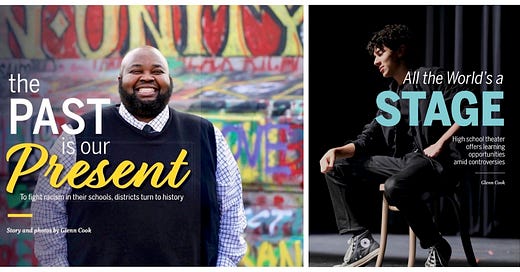Features
The Past is Our Present (December): How schools across the U.S. teach history—especially around topics of race—also looms large amid a cultural and political divide fueled by a summer and fall of protests over injustice and police misconduct. The “good, bad, and ugly” approach to history has long been controversial. However, the blowback is particularly fierce now among traditionalists angered by the tearing down of monuments and uncomfortable with the prospect of a curriculum that does not put Christopher Columbus, the Mayflower, and the Founding Fathers front and center. Written for American School Board Journal.
Engaging and Compliant (October-November): Since 2013, lawsuits targeting companies whose websites discriminate against people with visual and other disabilities have increased by almost 400 percent. What can staffing executives do? Industry expert David Searns of Haley Marketing has some suggestions. Written for Staffing Success, the magazine of the American Staffing Association.
Crime & Punishment (October): As a new wave of the Black Lives Matter movement gains momentum, many districts are examining how on-campus police officers contribute to the school-to-prison pipeline. School boards, which have supported a wide variety of often expensive security measures to prevent on-campus shootings and acts of violence, are rethinking their relationships with local law enforcement in the wake of worldwide protests against police brutality. Written for ASBJ.
Reopening Realities (August): Since mid-March, when school buildings abruptly closed and districts moved to distance learning due to the COVID-19 pandemic, board members and administrators have developing reopening scenarios. But, amid concerns about delayed learning, equity, and the physical and emotional toll the pandemic already has taken on children and staff, a new problem has emerged: the reality of severe budget cuts that further threaten the reopening of classrooms.
The Time is Now (August): For districts and school leaders, the twin calamities of the pandemic and protests following the killing of George Floyd have shined a harsh spotlight on the academic, economic, physical, and social and emotional health needs that face students of color as they return to school. Already, districts in several major cities — Minneapolis was the first — have terminated or are considering ending contracts with their local police departments in an effort to end some of the disparities against Black youth.
Plan for the Worst (June): Less than a month after the first U.S. cases were reported in Washington state in late February, the nation found itself in an unprecedented pandemic that has since altered many aspects of daily life. School buildings have been shut down and instruction moved—with widely varying degrees of success—online. In the ensuing upheaval, time-honored activities and traditions such as proms, field days, sports, spring musicals, and even graduation ceremonies were canceled as “social distancing” became the nation’s catchphrase.
All the World’s a Stage (February): High school drama departments have been shying away from controversial social topics amid objections over language and subject matter. In a country divided over social and political issues, with the capacity to turn a protest into a national story with a post or tweet, pushing the envelope on a high school stage can be risky. But some teachers are willing to take the risk.
Staffing Success — Will Bennett (January-February): A profile of Will Bennett, the American Staffing Association’s National Staffing Employee of the Year for 2020. Bennett left his job as the director of marketing and branding for a Major League Soccer team to take care of his daughter, who has severe dyslexia. Entering the world of contracting work led to a huge career shift that changed his life forever — and for the better. Written for Staffing Success.
Columns
As a contributing editor to American School Board Journal, I also write a communications column for each issue of the magazine.
Aggressive Common Sense (December): Rich Bagin, who is retiring after 28 years as executive director of the National School Public Relations Association, says communicators must use “aggressive common sense” in their work. Districts that withhold or try to spin information, rather than being straightforward, risk damaging the public’s ever-fragile sense of trust.
Beyond Information (October): The pandemic has underscored the important role public relations experts play in informing constituents. For Lesley Bruinton, public relations coordinator at Alabama’s Tuscaloosa City Schools and president of the National School Public Relations Association, messaging has required a “Goldilocks approach” — the balance “between too much, too little, and just right.”
Honoring the Class of 2020 (June): Tragic events bookend the lives of most of the Class of 2020. Born in the wake of the 9/11 terrorist attacks, this year’s seniors are graduating during a global pandemic, with commencement ceremonies postponed until summer, held virtually, or canceled. It’s one reason school communicators — already with more on their plate than they ever bargained for — are looking for a variety of ways to recognize the seniors.
Uncomfortable Conversations (April): For three years, Massachusetts’ Needham Public Schools have led an equity initiative that requires the community to embark on a series of difficult and uncomfortable conversations about race and cultural heritage. The result? A systematic approach to address district-wide equity efforts.
Telling Your Story (February): School boards regularly go through strategic planning, either developing a long-range mission and vision for the district or tweaking one that already exists. But how much attention does your district pay to the branding that does — and should — carry out your work in visible and public ways?



